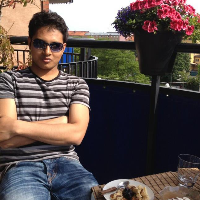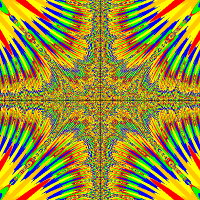Recently, I am working on a project named "Conway's game of life". Unluckily, I am not allowed to use the Greenfoot library function getNeighbours(…) in the Actor class. By the way, I found some some well made scenerios of "Conway's game of life" at this website, but there, the Greenfoot library function getNeighbours(…) is used. I even can't come up with good solution to make it without the library function getNeighbours(…). Can you please help me.
I am going to copy+paste the codes I found from this side.
import greenfoot.*; // (World, Actor, GreenfootImage, Greenfoot and MouseInfo)
import java.awt.Color;
/**
* The Grid consists of the lines and cells of the CA.
*
* @David Brown
* @03/16/2010
*/
public class CellularAutomata extends World
{
private GreenfootImage myGrid;
private Cell[][] myCells;
private int myWidth, myHeight, myCellSize;
/**
* Constructor for objects of class Grid. Calls methods to draw the
* grid lines, to create the array of cells and to place 23
* Fibonacci ants onto the grid.
*
*/
public CellularAutomata()
{
super(50, 50, 10);
myHeight = getHeight();
myWidth = getWidth();
myCellSize = getCellSize();
drawGrid();
createCells();
}
/**
* Tell each cell to save its last state in preparation for the
* next time step.
*/
public void act()
{
for(int i = 0; i < myHeight; i++)
for(int j = 0; j < myWidth; j++)
myCells[i][j].saveLastState();
}
/**
* Draw the lines of the cell grid.
*/
private void drawGrid() {
myGrid = getBackground();
myGrid.setColor(Color.red);
int endY = myCellSize * myHeight;
int endX = myCellSize * myWidth;
for (int i = 0; i < endX; i += myCellSize)
myGrid.drawLine(i, 0, i, endY);
for (int i = 0; i < endY; i += myCellSize)
myGrid.drawLine(0, i, endX, i);
}
/**
* Create the array of cells and turn some of them on.
*/
private void createCells() {
myCells = new Cell[myHeight][myWidth];
for (int i = 0; i < myHeight; i++)
for (int j = 0; j < myWidth; j++) {
Cell c = new GameOfLifeCell(myCellSize);
myCells[i][j] = c;
setInitCellState(c);
addObject(c, i, j);
}
}
/**
* Overridden in subclassed automata. This default routine does nothing.
*/
public void setInitCellState(Cell c) {
if (Greenfoot.getRandomNumber(4) == 0)
c.setState(true);
}
}
import greenfoot.*; // (World, Actor, GreenfootImage, Greenfoot and MouseInfo)
import java.awt.Color;
import java.util.List;
/**
* These are the cells of the CA. They save their last states to allow
* for parallel reevaluation of neighboring cells.
*
* @David Brown
* @03/16/2010
*/
public class Cell extends Actor
{
Boolean myFirstTime = true;
Boolean myState, myLastState;
GreenfootImage myBody;
int myNumNeighbors;
int myBodySize;
Cell [] myNeighbors;
/**
* Create the cell body's image and initialize state.
*/
public Cell(int cellSize) {
super();
myState = myLastState = false;
myBody = new GreenfootImage(cellSize, cellSize);
setImage(myBody);
myBodySize = cellSize - 2;
showState();
}
/**
* On first execution, find and save neighboring cell references.
* After that, apply cell rule and show cell state.
*/
public void act()
{
if (myFirstTime) {
List neighbors = getNeighbours(1, true, Cell.class);
myNumNeighbors = neighbors.size();
myNeighbors = new Cell[myNumNeighbors];
for(int i = 0; i < myNumNeighbors; i++)
myNeighbors[i] = (Cell)neighbors.get(i);
myFirstTime = false;
}
applyRule();
showState();
}
/**
* Save the previous state in preparation for the next time step.
*/
public void saveLastState() {
myLastState = myState;
}
/**
* Set the state of the cell.
*/
public void setState(boolean state) {
myState = state;
showState();
}
/**
* Get the state of the cell.
*/
public boolean getState() {
return(myState);
}
/**
* Flip the state of the cell.
*/
public void flipState() {
setState(!myState);
}
/**
* Count the surrounding cells that were on in the previous time step.
*/
public int countNeighbors() {
int sum = 0;
for(int i = 0; i < myNumNeighbors; i++)
if (myNeighbors[i].myLastState)
sum++;
return(sum);
}
/**
* Apply cell rule for timestep. Subclasses should override this method
* which does nothing.
*/
public void applyRule() {
}
/**
* Draw the body of the cell based on the state.
*/
private void showState() {
if (myState)
myBody.setColor(Color.black);
else
myBody.setColor(Color.white);
myBody.fillRect(1, 1, myBodySize, myBodySize);
}
}
import greenfoot.*; // (World, Actor, GreenfootImage, Greenfoot and MouseInfo)
/**
* Write a description of class GameOfLifeCell here.
*
* @author (your name)
* @version (a version number or a date)
*/
public class GameOfLifeCell extends Cell
{
public GameOfLifeCell(int cellSize) {
super(cellSize);
}
/**
* Apply the Game of Life rules to the current cell situation.
*/
public void applyRule() {
int numNeighborsOn = countNeighbors();
boolean state = myState;
if (numNeighborsOn < 2)
state = false;
else if (numNeighborsOn > 3)
state = false;
else if (numNeighborsOn == 3)
state = true;
myState = state;
}
}







